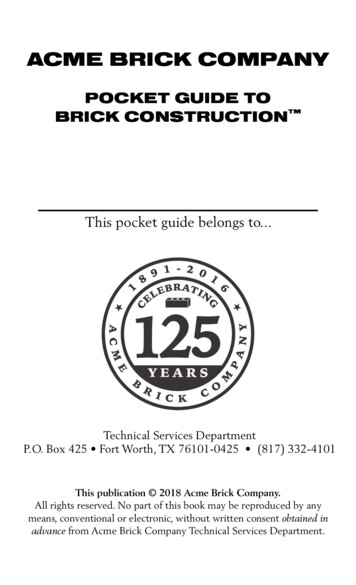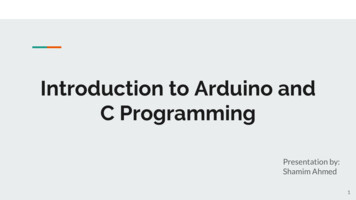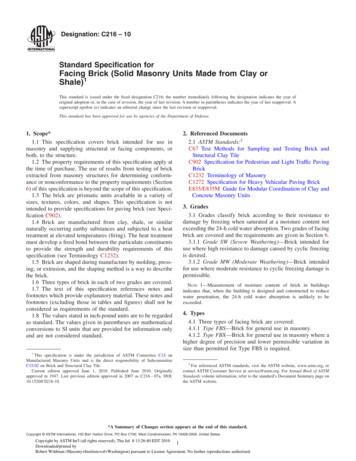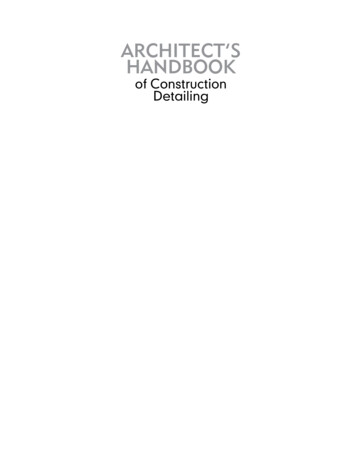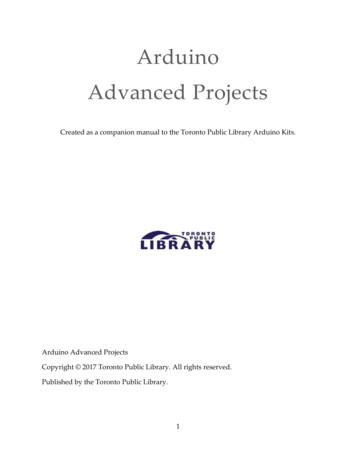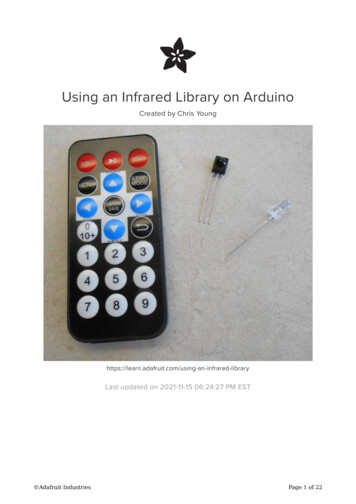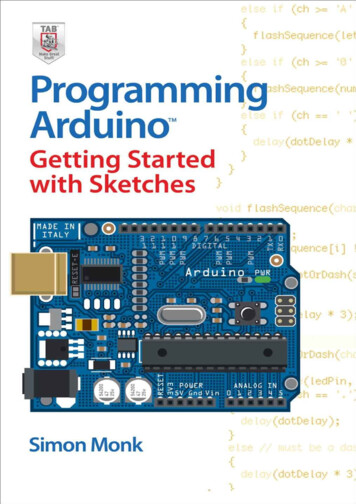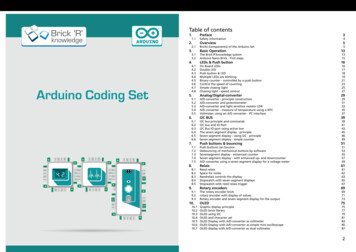
Transcription
Table of contents1.Preface 32.Overview 53.Basic Operation 134.LEDs & Push button 165.Analog/Digital-converter 296.I2C BUS 397.Push buttons & bouncing 518.Relais 619.Rotary encoders 6910.OLED 751.12.13.13.2Arduino Coding 0.110.210.310.410.510.610.71Safety information Bricks (components) of the Arduino Set The Brick‘R‘knowledge system Arduino Nano Brick - First steps On Board LEDs Double LED Push button & LED Multiple LEDs are blinking Binary counter - controlled by a push button Control the speed of counting Simple chasing light Chasing light - speed control A/D-converter - principle construction A/D-converter and potentiometer A/D-converter and light sensitive resistor LDR A/D converter - measure of temperature using a NTC Voltmeter using an A/D converter - PC interface I2C bus principle and commands I2C bus and IO Port I2C Bus IO port using active low The seven segment display - principle Seven segment display - using I2C - principle Seven segment display - simple counter Push buttons can bounce Debouncing of mechanical buttons by software Sevensegment display - enhanced counter Seven segment display - with enhanced up- and downcounter A/D converter using a seven segment display for a voltage meter Reed relais Space for notes Reedrelais controls the display Stopwatch with seven segment displays Stopwatch with reed relais trigger The rotary encoder brick rotary encoder with display of values Rotary encoder and seven segment display for the output Graphic display principle OLED brick library OLED using I2C OLED and character set OLED Display with A/D-converter as voltmeter OLED Display with A/D-converter as simple mini-oscilloscope OLED display with A/D-converter as dual voltmeter 57596162636567697173757779818385872
1.1 Safety 2.312.412.5Digital/Analog-converter Digital/Analog-converter and principle Simple D/A converter using PWM D/A-converter brick controlled by I2C D/A converter brick and potentiometer OLED and D/A converter at the A/D converter OLED and D/A converter at A/D converter with a sine signal Applications Measurement of a discharge function - display on OLED OLED and simple diode characteristic diagram OLED and transistor as common emitter circuit Switching of loads 1 Switching of loads 2 8989919395979910110110310510710913.Appendix 11114.Future 1411.Preface13.1 Listing - seven segment library with an example 13.2 Listing OLED library with example Note: Never connect the bricks directly to the mains power supply (115V/230V). There might be danger to life.Please only use the included power supply-bricks. The voltage of our power-supply modules is 9V, which is nota health hazard. Please also ensure, that no open wires are in contact with the mains power outlets. Otherwise there might be a danger of hazardous electric shocks. Never look straight into LEDs, since this may damageyour eye retina.Please connect the included polarized capacitors (tantalum/electrolytic) only with the positive side to the plusside of the power supply. If those polarized capacitors are connected not correctly, they can be destroyed andeven explode!Please remove the power supply brick every time you finished experimenting, to avoid the risk of an electricfire.111115The Brick‘R‘knowledge was presented first time at the HAM radioconference 2014 by DM7RDK (callsign of Rolf-Dieter Klein) .Now here we can present the Arduino coding set.The special thing about the bricks is that both sides of the connectors contain a hermaphrodite, which can connect to itself and alsocan be bending while maintaining contact with a maximum of 6.3amperes at 110 Volt. Of course we work with low voltages around 9Volt to be safe.Two contacts are reserved for the ground connection, allowing easyto document circuits, which can be uploaded by taking a photo toany social network for example. Even a 3D stackup is possible forcomplex circuits.Have fun with the set and may ideas.Rolf-Dieter Kleinrev 1.134
2.Overview2.1 Bricks (components) of the Arduino SetThis brick contains two LEDs (light emitting diode). The LEDs are in series with a2.2kOhm resistor to limit the maximum current. They are optimized for a 2mAcurrent flow.Both resistors are connected to ground, this allows connecting the brick directlyto the output of a Arduino Nano brick. The two signals are also connected to theopposite site for feeding through the signals.LEDArduino NANO: This is the heart of our set. The processor is connected to the top side into the connectors. Theprogramming is done like for other Arduino products using a PC and the Arduino development system, whichcan be downloaded from the homepage of the Arduino products.For programming the Nano is also supplied via the USB-Port, also possible is an additional 9V supply. The USBPort can be disconnected after programming is done.Attention never directly connect the bricks contacts of any IO to the 9V supply. Though there is a small protection circuit it won‘t last very long. The IOs are used with a 5V level. 9VSC LS DA I²CMOSI SCLKLEDB0SSMISCB13,3V 5VLEDAdr. 70-7E 9VP6 P7P4 P2 P3 P5SCLSDADownsideSDAI²C PIO8574ATP0 P1 9VAdr:18-1FI²C 12BIT DACP1SD A123Voutab5SC LP2P3SC LSD AImax 20mAThe Arduino has a special bus called I2C which allows connection of additionalbricks via this serial bus. The 8574 is an integrated circuit which is used for extending the number of IO ports. Therefore 8 lines are provided which can be used asinput or output port. The I2C bricks uses 3 address lines which can be set directlyat the bottom of the brick for a maximum of 8 bricks at one bus. There is another IC called 8574T which can be used for additional 8 addresses. Both allow of8x8 8x8 128 different IO ports to be used. All IO ports are available at the connectors of the brick, but P4-P7 at the bottom connector.D/A converter brick: Using the I2C bus the output value can beset with 0.4095 different levels. This is assigned to a propotionalvoltage.The bricks can be set for three different I2C addresses, allowinga maximum of three bricks at the same I2C bus.In addition different output voltage ranges can be set via jumpers at the front site. Be careful when changing the jumpers.The output allows for a maximum of 20mA.0-5V0-10V0-20V -5V -10VP3P1PD 6PD 4PD 5PD 7USBA0A1TxRxNA NOtoBr ick R PD2IO assignmentPD0 - 0PD1 - 1PD2 - 2PD3 - 3PD4 - 4PD5 - 5PD6 - 6PD7 - 7PD3A0A1A2A3A4A5A6-analog 0analog 1analog 2analog 3(SDA) - analog 4(SCL) - analog 5- analog 6A7 - analog 7port OPB4B0PB0parameter#13#11#9#10#12#8PB0 - 8PB1 - 9PB2 - 10PB3 - 11PB4 - 12PB5 - 13P2VoutLEDSCLA7A3A2A6This brick contains two LEDs (light emitting diode). The LEDs are in series with a2.2kOhm resistor to limit the maximum current. They are optimized for a 2mAcurrent flow.Both resistors connected to the opposite site. This allows a floating power level.To be similar to the above LED brick, a ground brick needs to be connected to thecathode. The cathode is at the resistor side, the LED symbol indicates this with asmall bar.Adr.011011JP1The back side has a printed version of the voltage assignmentfor the jumpers and for the address jumpers.6
Adr:8x,XxOLED: Organic Light Emitting Diode. Especially there is a matrix of 64x48 LEDs.Each of the can be addressed as a single LED by use of commands via the I2C bus.This allows for multi line text output as well as simple monochrom grafics. 9VI²C OLED 64x48SC LSC LSD ASD AThe corner-brick connects two bricks with a 90 angle. 9VPCF8574 TAdr:40,44,48,4C 9VI²C 7-Segment-LEDSC LSC LSD ASD A7-Segment-Display: Its using 7 light emitting bars and a single dot. Each of themcontains a LED. The LEDs are addressed with the help of two 8574T circuits (16ouput ports are used for the two displays). On the backside there is a small switcharray, with which you can set the I2C address. A maximum of four such bricks canbe operated on a single I2C bus.The T-bricks is used for junctions. It can also be used instead of a corner-brick. 9VThis capacitor has a capacitance of 10μF. A charging voltage of 1V is achievedalready after 10μs, when loaded with a current of 1A. Capacitors must not exceedtheir specific maximum voltage.With a double T-brick also junctions can be implemented. In this case both middlecontacts are separated.10µF 25VSi DiodeThe special feature of this diode is that it can rectify voltages up to 100V and canalso switch very high frequencies of up to 100MHz. It is operated in forward direction. In reverse direction the current flow is very low.The ground-brick closes a circuit. This allows a much easier usage and saves thenumber of bricks needed to complete a circuit. The ground-brick connects the twocenter contacts with the two outer contacts used as ground connection.AK1N414 878
- 1A9VThe power-supply-brick is the second way to power a circuit. It provides a stabilized DC voltage of 9V with a maximum short-circuit-proof current of 1A. Theground is connected to the minus pole, so that no further ground-bricks must beused to complete the circuit. A green LED signals the correct insertion of the brick.To reduce the risk of electronic malfunctions the power-supply-brick should bedisconnected after an experiment.The potentiometer is a manually variable resistor. The third contact (wiper) changes the amount of electrical resistance by moving it from left to right. Can be adjusted in the range of 0 to 10k. If the wiper or one of the other contacts is connected directly to the power supply, a short circuit will appear. This must be avoided!The potentiometer has a maximum power of approximately 0.125 watt.A NTC-resistor (Negative-Temperature-Coefficient) follows the temperature changewith a positive gradient. For example if the temperature increases, the electricalresistance decreases.The resistance value as on the circuit symbol is 10k at standard 25 C room temperature.The NTC resistor is well suited as a temperature sensor.The push-button-brick is an electromechanical switch that allows a conductiveconnection only during pressing and holding the button. At the moment of releasethe connection will open again and the button returns to its inital position.10kReed RelaisLDR 031N4148This brick has an electrical resistance of 10k. This value corresponds to a currentflow of 100μA at a voltage of 1V. As all our resistors, the resulting power dissipation should not exceed 0.125 watt.The LDR 03 is a light-dependent resistor. The more light falls on the sensor, thesmaller the resistance will be. The values vary from a few 100 in bright environment and several kilo Ohm in the dark. The change of the resistance value is continuous.1N4148A reed contact switch (thin tube) is activated by an outside magnetic field. This magnetic field can be generated by a permanent magnet or an electromagnet. Reedswitches have a low remanent magnetization.They turn on whenever an external magnetic field is added in the same directionand turn off when the external magnetic field is removed. They are used as a proximity switch.9Double resistor with protection diodes. This can be used especially to protectthe analog input of the Arduino Nano brick. The diodes must point towards theanalog inputs of the Nano brick. They protect against negative voltages. The Nanobricks itself also contains two resistors with around 100 Ohms each. The 2.2k Ohmresistors in this brick can also protect the input against a 9V supply but don‘t connect them for a prolonged time, the analog inputs are limited to a 0-5V range.10
GDIPD079N06L3n-MOS100Gatemax. 60V50ApeakThis brick connects the separate center contacts. By seperating and crossing thelines, the connection can be changed.Not connected double crossing. In this case the two opposite middle contacts areconnected to each other. The center is isolated against shorts.CnpnB0,8A22kS ESD12B45VOur field effect transistor controls the current flow between drain and source viathe voltage applied at the gate. The special thing about this device is that theconnection between the gate and source is very high impedance. Field effect transistors are also called MOSFET (Metal Oxid Semi-channel Field Effect Transistor) orreferred to as “MOS“.There are different types of MOS, our brick is an enhancement type n channelwhich is normally in off condition. This means that a positive voltage above a certain threshold voltage needs to be applied to the gate, so the MOS begins conductbetween drain and source.This MOSFET can be used with up to 60V between source and drain. A peak current of 60A is also possible, of course not both at the same time. Attention: thecontacts of the brick system can withstand a maximum of 6.3A per contact.The gate input is protected by an ESD diode and an additional 22kOhm resistor tothe source contact.This brick contains the same npn transistor. It controls the flow of the current between the collector (C) and Emitter (E) via its smaller current into its base contact(B).The base should be positive in relation to the emitter for normal operation. Inaddition this brick offers a connection of the base to the left side and to the rightside. This allows a much easier construction of complex circuits.EBC817This allows connecting wires or components directly into the circuit. Pressing asmall screwdriver in the slots above opens the contact and a wire can be insertedfrom the side. After release of the screwdriver pressure the wire is fixed.A very special bricks, designed for using the Nano bricks. In addition to the contacts at the upper side, also contacts at the bottom are available. With the help ofthis bricks those 4 contacts are connected to the upper side with 2 each. This allowsnormal bricks to be used for connecting the lower connector.BEnterA10 kConnects the two contacts at the top level from one side to the other but also thefour contacts at the bottom side which are independant from each other.IncrementalEncoderDownsi deUP11Rotary encoder.Such elements are often used on operating panels. There are two contacts with a90 degree phase shift. The CPU can use this information to get the rotation direction. Pressing the button closes an additional contact. Depending on the usedrotary encoder type, 18 to 36 contact closes per revolution are activated.12
3.Basic Operation3.1 The Brick‘R‘knowledge systemThe ground brick is a special brick in our system. It saves the use of additional connector bricks or wires. Thisshows the secret of the four contacts. The two middle contacts are used for signal transmission, according tothe print on top. The outer two contacts are used for closing the circuit, that means allowing the current toflow back to the power source. Its called ground brick, because the technicans often call it ground or 0V level.rightThis is an example of a correctly connected brick. The connection has small contacts and also isolating parts which fitexactly together. The isolating parts are used to separatethe contacts and avoiding shorts.This ground simplifies the electronic circuit by using a symbol for the return path. Our ground brick also connects both inner contacts to ground that means the outer contacts. All bricks connect the outer two contactstogether even if it‘s not printed on the label.no contactwrongHere the connector is shifted by one position, the contactsare all isolated, and therefore no contact is done. If shiftedonce more a short can result. Carefully check all connectionsbefore you power up a brick circuit.Attention: its really important to have a good and right adjusted contacts. Shorts can also lead to destructionof bricks and even result in fire to the system.Be careful when connecting the bricks together. If shifted, an open or short circuit can result. They must fitexactly together.Our Arduino Set has an additional contact level.The contacts on the bottom allow for additional4 signals per side. When you connect such bricks,be very careful when you plug them together. Anadditional nose is used to guide the connection.This nose also prevents the bricks from bendingup and down which is possible with normalbricks.Important: Always check your connections for precise contacts.1314
4.1 On Board LEDsThe Arduino Nano has a lot of in- and output ports, some of them a wired to our contacts on the Nano boardinterface. There is a LED on the printed circuit board of the Nano itself, which is wired to port 13 ( PB3).With our simple programming example you can let it blink.-The Arduino Nano brick can be supplied with either the USB port or by an external power supply. You can useour 9V power supply for this purpose. But be very careful. Never connect this brick to any other of the contactsexcept for the power supply input, where 9V is written on the label. This might destroy the Nano brick.If you get a plain Nano brick, there might be already a test program running which lets the LED blink on theNano board. To use your own program, you need to connect the brick via an USB cable to your PC. You shouldhave installed the Arduino Development Software. Then you select the Arduino Nano as board and select theaccording COM port for the communication.LEDs & Push button9V3.2 Arduino Nano Brick - First steps4.1A // only executed once after startup of the arduinovoid setup() {pinMode(PORTLED,OUTPUT); // Port 13 assigned as output}B1// this loop is called in repetition by the arduinovoid loop() {// set output to a high leveldigitalWrite(PORTLED,HIGH); // high means 5V in our casedelay(1000); // 1 second delay 1000 milliseconddigitalWrite(PORTLED,LOW); // set low level on outputdelay(1000); // wait for an additional second} // end of loopPD 6PD 4PD 5PD 7What happens? The red LED on the printed circuit board of the NANO shouldblink with around 1 time per second.MOSI SCLKSC LS DA I²CB0SSMISC3,3V 5V-9V 9V1A A7A3A2A6USBA0A1NA NO// EN 1#define PORTLED 13 // this defines a symbol with the value 13TxRxYou can adjust the on/off time by changing the parameter at the delay command.toBr ick R 9VSC LS DA I²CB0SSMISCB13,3V 5VA7A3A2A6PD 6PD 4PD 5PD 7USBA0A1NA NOtoBr ick R PD215PD3MOSI SCLKPD2PD3TxRxBelow we printed a table of all IO Port assignments (0-13 : logical number) and theaccording physical names which are split into Port B and D from the Arduino processor.IO AssignmentPD0 - 0PD1 - 1PD2 - 2PD3 - 3PD4 - 4PD5 - 5PD6 - 6PD7 - 7Some of those ports are at the bottomside of the brick. You can get access tothese ports by using our special brick,which has wired those bottom connections to the top side. PD2 and PD3 forexample are accessible directly on thetop side of the brick. PB0 and someother lines have a multiple meaning,which is listed below. Examples willfollow.PB0 - 8PB1 - 9PB2 - 10PB3 - 11PB4 - 12PB5 - 13port PB4B0PB0parameter#13#11#9#10#12#816
4.2 Double LED4.3 Push button & LEDNow let‘s directly connect one of our bricks to the Nano. Therefore we use one the double LED brick withinternal ground connection. The Nano uses two of the inner contacts as separate IO, which can now be directly assigned to the LEDs. The outer two contacts are used for the ground connection which is not shown in theschematic. Here we connect the LEDs to the ports PD2 and PD3, which will be programed as outputs. 2 and 3is also the numbering used in the Arduino sketch. When keeping the connection via USB the 9V brick is notnecessary in this case. After programming successfully the LEDs are blinking one or the other changing. The LEDbricks have different colors, which you can choose as you like. Be careful to use the LED bricks with the groundsymbol inside. We will show later how you connect the other bricks.Now we inserted an additional brick with a push button. When pressing the botton a connection to ground isdone. If the button is open, the input port of the Nano would be undefined. To solve this usually a pullup resistor towards 5V (not 9V!) is necessary, but the Adrunio Nano has a nice option called INPUT PULLUP. This setsan internal pullup resistor and eliminates the need to wire an external resistor. The internal resistor is around20kOhm towards 5V. The push button cannot be connected directly to the Ports 4 or 5, as they are contacted atthe bottom side. Therefore we use our special brick. This wires the bottom contacts to the upper side.In our case we connect both ports PD4 and PD5 at the same time to the contacts of the push button, which isno problem as long as both ports are defined to be input. PD6 and PD7 are now also on the upper side but notused.B1PD 6PD 4PD 5PD 7USBA0A1NA NO9V1AB0SSB1PD 6PD 4PD 5PD 7USBtoNA NOTxRxtoPD3Downsi deUPBr ick R PD2PD3LEDLEDLEDLEDWhat happens? The two LEDsblink in a one second intervalalternating.Port 4void setup() {pinMode(PORTLED2,OUTPUT); // Port 2 to be outputpinMode(PORTLED3,OUTPUT); // Port 3 to be outputpinMode(PORTSWTTCH4,INPUT PULLUP); // Port 4 asinput with pullup resistor}MISCA0A1Br ick R PD2 9VA7A3A2A6TxRx#define PORTSWTTCH4 4 // push button to(und 5)3,3V 5V3,3V 5VA7A3A2A6#define PORTLED2 2 // Symbol gets the value 2#define PORTLED3 3 // and here same for 3MOSI SCLKB0SSMISC// this loop is called in repetition by the arduinovoid loop() {digitalWrite(PORTLED2,HIGH); // set the output to a high leveldigitalWrite(PORTLED3,LOW); // set the output to a low leveldelay(1000); // wait one seconddigitalWrite(PORTLED2,LOW); // set the output to a low leveldigitalWrite(PORTLED3,HIGH); // set the output to a high leveldelay(1000); // wait one second}SC LS DA I²CSC LS DA I²CMOSI SCLK 9V// EN 3 Double LED and Button // this loop is called in repetition by the arduinovoid setup() {pinMode(PORTLED2,OUTPUT); // Port 2 to be outputpinMode(PORTLED3,OUTPUT); // Port 3 to be output}- 9V-#define PORTLED2 2 // Symbol gets the value 2#define PORTLED3 3 // and here same for 31A// EN 2 double LEDvoid loop() {if (digitalRead(PORTSWTTCH4) LOW) { // onlywhen the button is presseddigitalWrite(PORTLED2,HIGH); // set the output to a high leveldigitalWrite(PORTLED3,LOW); // set the outputto a low leveldelay(1000); // wait one seconddigitalWrite(PORTLED2,LOW); // Ausgang aufniedrigen Pegel schaltendigitalWrite(PORTLED3,HIGH); // set the output to a high leveldelay(1000); // wait one second} // on of polling the button} // end of loopWhat happens? The two LEDs blink in a one second interval alternating as long as the button is pressed.1718
4.4 Multiple LEDs are blinking-9VThe LEDs show a binary code of a counter. This counter runs from 0 to 15. For this to happen, single bits of thecounter variable are checked and then assigned to the different LEDs, which can be on or off. Attention theLEDs have the strange sequence 2, 3, 5 and 4, which is also handled in the programming code.This time we use a new term „static“ which means that a variable keeps its value also between calls. This is likea global variable.Below we listed the binary code. The counter is implemented by the assignment „counter counter 1“. Butthis will lead to an overflow, depending whether the variable is a 16 bit integer or a 32 bit integer. Usuallythis is not a problem, but it‘s more clear to use a special instruction to prevent this. We use the „&“-operationwhich is a logical AND. The value of 0xf is also called mask value. With the assignment „counter (counter 1)& 0xf“ the counter is incremented first and then the AND operation is done, which only keeps the least for bitsof the variable „counter“ and so prevents an overflow.1A SC LS DA I²CMOSI SCLK 9VB0SSMISCB13,3V 5VA7A3A2A6PD 6PD 4PD 5PD 7USBA0A1NA NOTxRxtoDownsi deUPBr ick R 0111100110111101111// EN 4 Multiple LEDs ORTLED4PORTLED52 // now define 4 LEDs3 // use PD2,PD3,PD4,PD54 //5void setup() { // start initializingpinMode(PORTLED2,OUTPUT); // Port 2pinMode(PORTLED3,OUTPUT); // Port 3pinMode(PORTLED4,OUTPUT); // Port 4pinMode(PORTLED5,OUTPUT); // Port 5}asasasasoutputoutputoutputoutputvoid loop() {static int counter 0; // keep the counter value// because we use a static variable// withotu static it will be reset to 0// each time the loop is enteredif (counter & 1) { // check bit 0digitalWrite(PORTLED4,HIGH); // right LED} else digitalWrite(PORTLED4,LOW); //if (counter & 2) { // check bit 1digitalWrite(PORTLED5,HIGH); // left LED} else digitalWrite(PORTLED5,LOW); // nextif (counter & 4) { // check bit 2digitalWrite(PORTLED3,HIGH); // // set to 1} else digitalWrite(PORTLED3,LOW); //if (counter & 8) { // check bit 3digitalWrite(PORTLED2,HIGH); // now last bit 3} else digitalWrite(PORTLED2,LOW); //delay(1000); // wait fro 1sec 1000mscounter (counter 1)& 0xf; // this keeps the counter between 0.15} // end of the loopWhat happens? The four LEDs show the binary count from0000 (all off), then 0001, 0010, 0011 to 1111 (all on).Then all repeats.20
4.5 Binary counter - controlled by a push buttonCounting is done every second. Now we can build a very simple stopwatch by adding a push button. The stopwatch counts only if the button is pressed.Below a table helping for conversion. Later on we will implement a stopwatch which a decimal output andmuch more comfort.The button is connected to both ports 6 and 7. We use port 7 for polling the button only, the short to port 6does not matter because it defaults to an input port without pullup.Now the counter should keep counting as long as the button is pressed. But it overflows to zero after reachingthe maximum value of 1111 15.-9Vdecimal01234567891011121314151A SC LS DA I²CMOSI SCLK 9VB0SSMISCB13,3V 5VA7A3A2A6PD 6PD 4PD 5PD 7USBA0A1NA NOTxRxtoDownsi deUPBr ick R 0110011110001001101010111100110111101111// EN 5 Multiple LEDs and control by PORTLED4PORTLED52 // now define 4 LEDs3 // use PD2,PD3,PD4,PD54 //5#define SWITCH7 7 // the button is wired to PD7void setup() { // define all inputs and outputspinMode(PORTLED2,OUTPUT); // Port 2 as outputpinMode(PORTLED3,OUTPUT); // Port 3 as outputpinMode(PORTLED4,OUTPUT); // Port 4 as outputpinMode(PORTLED5,OUTPUT); // Port 5 as outputpinMode(SWITCH7,INPUT PULLUP); // Port 7 as input with pullup// a pullup is an internal resistor, which is programmable// if the button is not pressed and undefine condition at the// input would result. With the pullup the return of a high value/// that is a 1 value is returned.}void loop() {static int counter 0; // important the use of staticif (counter & 1) { // check bits 0.3 one after the otherdigitalWrite(PORTLED4,HIGH); // right LED} else digitalWrite(PORTLED4,LOW); //if (counter & 2) { // check bit 1digitalWrite(PORTLED5,HIGH); // left LED} else digitalWrite(PORTLED5,LOW); //if (counter & 4) { // check bit 2digitalWrite(PORTLED3,HIGH); //} else digitalWrite(PORTLED3,LOW); //if (counter & 8) { // check bit 3digitalWrite(PORTLED2,HIGH); //} else digitalWrite(PORTLED2,LOW); //// define the delay time for maximum count speeddelay(1000); //wait for a second// now check teh button at this pointif (digitalRead(SWITCH7) LOW) { // coutn if pressedcounter (counter 1) & 0xf; // 0.15 cyclic counter} // only if pressed, also hold the counter value} // end of loopWhat happens? If the button is pressed and only then the LEDs show the binary value of the counter from 0000, 0001.to 1111 (all on), then 0000, 0001 in a cycle manner. If the button is releasedthe currrent counter value is displayed and does not change.22
4.6 Control the speed of countingWith a push button you can do other things also. For example control the counting speed. There is only a minimal change in the program. Instead of enabling the counter as before, now the parameter of the delay() instruction is changed. For a pressed button it‘s using 200ms and for a non pressed button its using 1000ms 1secas a delay. Important to know is that the count speed is not exactly what is used in the delay, as the executiontime of instructions in-between must be added to the delay time. The delay is very precise using the crystaloscillator of the CPU. To adjust you can try a value little bit lower, but there are other programming ways toimplement this more precise (and more complicated).// EN 6 speed of counting is ED3PORTLED4PORTLED52 // now define 4 LEDs3 // use PD2,PD3,PD4,PD54 //5#define SWITCH7 7 // the button is wired to PD7-9Vvoid setup() { // IO definierenpinMode(PORTLED2,OUTPUT); // PortpinMode(PORTLED3,OUTPUT); // PortpinMode(PORTLED4,OUTPUT); // PortpinMode(PORTLED5,OUTPUT); // PortpinMode(SWITCH7,INPUT PULLUP); //}1A SC LS DA I²CMOSI SCLK 9VB0SSMISCB13,3V 5VA7A3A2A6PD 6PD 4PD 5PD 7USBA0A1NA NOTxRxtoDownsi deUPBr ick R PD2PD32 as3 as4 as5 asPortoutputoutputoutputoutput7 as input with pullup.void loop() {static int counter 0; // important the use of staticif (counter & 1) { // check bits 0.3 one after the otherdigitalWrite(PORTLED4,HIGH); // right LED} else digitalWrite(PORTLED4,LOW); //if (counter & 2) { // check bit 1digitalWrite(PORTLED5,HIGH); // left LED} else digitalWrite(PORTLED5,LOW); //if (counter & 4) { // check bit 2digitalWrite(PORTLED3,HIGH); //} else digitalWrite(PORTLED3,LOW); //if (counter & 8) { // check bit 3digitalWrite(PORTLED2,HIGH); //} else digitalWrite(PORTLED2,LOW); ////if (digitalRead(SWITCH7) LOW) { // if presseddelay(200); // wait only 200ms inbetween} else { // else count slowdelay(1000); //with 1 sec inbetween} // then continue// always count upcounter (counter 1)& 0xf; // 0.15 counter cyclic}LEDLEDLEDLEDWhat happens? If the button is pressed the counter is incremented every 200ms, that is the LEDsshow the counter state 0000, 0001 . 1111 (all on) much faster then if the button is not pressed anda ch
Now here we can present the Arduino coding set. The special thing about the bricks is that both sides of the connec-tors contain a hermaphrodite, which can connect to itself and also . 12.1 Measurement of a discharge function - display on OLED 101 12.2 OLED and simple diode characteristic d
